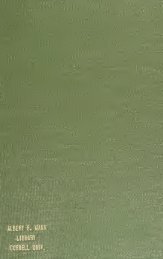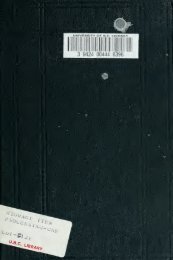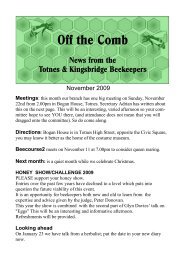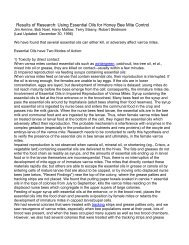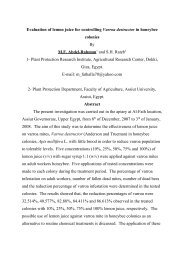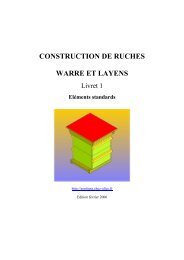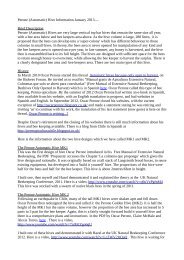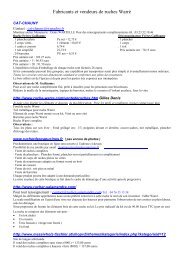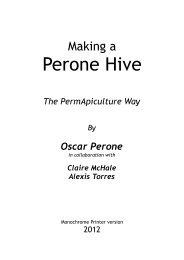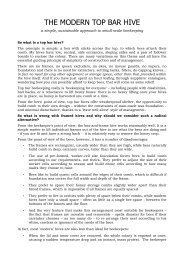You also want an ePaper? Increase the reach of your titles
YUMPU automatically turns print PDFs into web optimized ePapers that Google loves.
Observation<br />
Explanation<br />
On a day of main flow, <strong>the</strong>re is<br />
a great deal of trafficking between<br />
<strong>the</strong> alighting boards of<br />
two neighbouring colonies; it<br />
takes place directly between <strong>the</strong><br />
hive fronts but can also take<br />
place along more complicated<br />
routes.<br />
Latent robbing! One colony is robbing ano<strong>the</strong>r in <strong>the</strong><br />
most civilized fashion. A screen placed between <strong>the</strong><br />
hives is more often than not flown over or around.<br />
The robbers even enter <strong>the</strong> hive. This robbing is tolerated<br />
but is not satisfactory to all <strong>the</strong> colonies.<br />
Latent robbing can sometimes explain abnormally<br />
large harvests.<br />
In warm heavy wea<strong>the</strong>r,<br />
clumps and barbs of bees collect<br />
from <strong>the</strong> hive. <strong>At</strong> <strong>the</strong> same<br />
time strong ventilation occurs<br />
although o<strong>the</strong>r activity is very<br />
weak.<br />
When <strong>the</strong> interior temperature of <strong>the</strong> hive is too high,<br />
a large part of <strong>the</strong> colony leaves it; <strong>the</strong>ir instinct<br />
warns <strong>the</strong>m of different dangers (softening of <strong>the</strong><br />
combs, rupture of <strong>the</strong> combs loaded with honey or<br />
brood). If <strong>the</strong> temperature continues to rise above<br />
36° C, <strong>the</strong> brood suffers and can die. This dead brood<br />
decomposes in <strong>the</strong> cells, but one must never confuse<br />
this with foul brood. Immediate aeration is required.<br />
This situation occurs often in hives facing south as<br />
<strong>the</strong>y have no protection against <strong>the</strong> direct rays of <strong>the</strong><br />
sun.<br />
A few colonies assemble on <strong>the</strong><br />
front of <strong>the</strong> hive, this even on a<br />
less hot day. A strong smell of<br />
honey emanates from <strong>the</strong> hive<br />
entrance.<br />
The super are full. The honey is already collecting in<br />
<strong>the</strong> brood chamber of <strong>the</strong> hive. (The last two observations,<br />
like many o<strong>the</strong>rs, may be made in July or in<br />
August depending on <strong>the</strong> temperature and altitude).<br />
As soon as possible space must be made, o<strong>the</strong>rwise<br />
<strong>the</strong>re is a risk of swarming or of <strong>the</strong> brood chamber<br />
becoming flooded with honey.<br />
The bees of a secondary swarm<br />
run in all directions; on <strong>the</strong> aligting<br />
board, on <strong>the</strong> front of <strong>the</strong><br />
hive and not uncommonly to a<br />
neighbouring colony with a<br />
good queen.<br />
The queen has not returned from her mating flight.<br />
The swarm immediately calms down if one gives it a<br />
caged, fertilized queen. If one has a small colony with<br />
a fertilized queen, one can unite <strong>the</strong>m without provoking<br />
a fight. If all else fails a frame with a capped<br />
queen cell is sufficient.<br />
39



